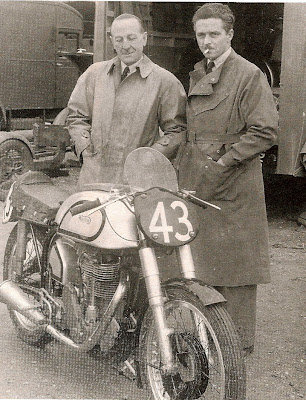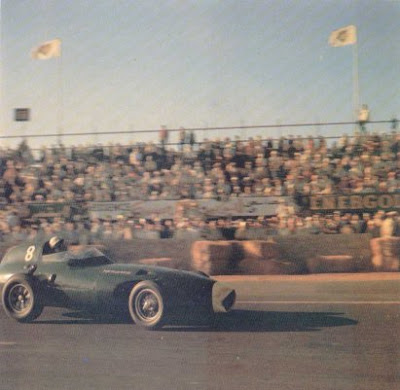 Research into the history of VMT816RC inevitably brought up the question - where did Norton get the idea for a 'Squish' combustion chamber, from which Veloce gained their own Production TT victory in 1967?
Research into the history of VMT816RC inevitably brought up the question - where did Norton get the idea for a 'Squish' combustion chamber, from which Veloce gained their own Production TT victory in 1967?The answer, in Norton's case, was a Polish engineer by the name of Leo Kusmicki (1911-82), who, the story goes, began to make suggestions to Joe Craig, legendary race boss at Norton, about how he might improve the performance of the aging 'Manx' OHC engine. In the 1940s Kusmicki was employed by the Norton factory as a 'sanitary' engineer, i.e., a janitor! Who was this broom-pusher to tell the indomitable Mr. Craig how to make his engines faster?
The story of Leo Kusmicki, like so many invisible heroes, has never been fully told; a web search reveals no photographs, only a few parroted mentions of the high points of his life. Undoubtedly his lack of renown suited his character, for he made no pains to publicize the contributions he made to the English motorcycle and Automotive industry from the 1940s through the 70s. From what little is published, we know that Kusmicki was a lecturer at Warsaw University in the late 1930s, specializing in internal combustion theory. He must have also been a pilot, if not yet in the Polish Air Force, then as a private citizen, for he managed to escape the two-sided attack on Poland in September 1939 from Germany and the Soviet Union, and make his way to England.

A sidebar here on some WW2 history; it's often repeated that Poland fell 'in a day' to the oncoming German Blitzkreig, with images of Polish horse-mounted cavalry facing Panzer tanks to their doom. The truth is more fierce - the Poles fought like demons against an invader with vastly superior forces and armaments, and managed to wipe out fully 30% of German heavy artillery, 285 of their planes, and 16,000 troops. About 66,000 Poles were killed, with almost 700,000 captured; lopsided yes, but Hitler was shocked at his losses. Josef Goebbels, Nazi Minister of Propaganda, spun stories about a 'walk through' victory in the East which resonate to this day, as do many other of his highly effective fabrications - the man was good at his job. Other forgotten tidbits; three Polish mathematicians, just weeks before the invasion, cracked the German 'Enigma' encryption code, and managed to smuggle the information to England via France which greatly eased intelligence during the War.

The Polish Air Force, in common with much of its military, managed to escape through Hungary to France, just in time for Germany's invasion of that country. Kusmicki would have had been a hardened veteran pilot by the time the Polish military-in-exile escaped to Britain after the fall of France, officially establishing themselves in June 1940 on English soil. The Polish Air Force became legendary during the Battle of Britain for their effectiveness (using English planes - Spitfires and Hurricanes), and Squadron 303, named after Polish-American hero Gen. Tadeusz Kosciuszko, had twice the 'kill' rate of the R.A.F., as they had already been fighting the Luftwaffe for a year and were successful tacticians.

By the time the War was over in 1945, Kusmicki had been fighting for 6 years on foreign soil, in the branch of the military with the highest casualty rate, with his homeland occupied first by Germany, then post-War by the Soviet Union; there was no going home. After such an experience, is it any wonder he took refuge sweeping floors at Norton Motors?

Which is where Joe Craig discovered a secret asset already within his building, who extended the useful racing life of the beloved Manx for another ten years. The revelation of Kusmicki's deep proficiency in combustion chamber theory came inauspiciously, with an upbraiding! Charlie Edwards, a Norton race shop employee, remembers (vide Mick Woolett's 'Norton' - sadly out of print):
"When I came in one morning he [Kusmicki] was sweeping the experimental department and we got talking. It was soon obvious this man was no ordinary sweeper-up and we were chatting away when Joe Craig came in. He was like a bear with a sore head most mornings and he gave Leo a right dressing-down for standing talking and not getting on with it - and then I got one! But I told Joe that this guy might be able to help, and that he should have a talk with him. Well, it wasn't long before Leo was in the drawing office and in my opinion it was he who vastly improved first the 500 then the 350, He was brilliant on cam profiles, combustion chamber shapes, valve timing, porting - the lot."
The 'Model 30' racing engine had changed little from its Arthur Carroll revamp in 1929; Joe Craig (above), while a very determined and canny race team manager for Norton, was certainly no engineer, and developed his engines on a 'suck it and see' basis, rather than from first principles or theoretical research. Thus, to have an expert in engine theory land literally inside his office was something of a miracle... one for which he showed no gratitude publicly, but such was his manner. He was a hard man, had been a successful motorcycle racer in the 1920s, and followed this with nearly 25 years at the helm of the Norton race team, which had possibly the greatest run of success in International level racing, with the least financial support! Under his helm Norton won 9 World Championships, 27 TTs, and countless GPs.

The principal change Kusmicki made to the Manx engine for 1950 was to create a 'Squish' combustion chamber, although a host of modifications were made to the engine and chassis that year, including the introduction of the Featherbed frame. His efforts on the engine raised power by 20%, from 30hp to 36hp on the 350cc engine. The totally redesigned Manx made its début in the hands of young star Geoff Duke that April, where he smashed race and lap records, a situation repeated at the Senior TT that year, where Duke's race average bettered the previous lap record at over 92mph. Much praise was given to the McCandless brothers' new frame design, and Joe Craig was publicly praised as 'the Maestro of Poke'... although of course, no mention was made of the quiet Pole who had completely revised the Norton racer. But, Geoff Duke (above) certainly knew the score, saying in the 1980s, "After the way he [Kusmicki] transformed the singles, particularly the 350cc, I had great respect for him." (vide Woollett).

Kusmicki continued to develop the Manx for a few years, and was heavily involved in the design of a four-cyliner DOHC Norton racer, but funds for racing grew short worldwide by the mid-1950s, and the Norton race shop was shut down Such talent, even if unsung, does not go unnoticed, and Tony Vandervell, a major stockholder in Norton Motors Ltd, had a passion for Formula 1 car racing. His father, Cornelius Vandervell had purchased a large quantity of Norton stock back in the 1920s (the C.E.V. magnetos which graced Norton motorcycles in the mid-20s were C.E.Vandervell's product, and while technically inferior to an M.L. or Lucas magneto of the day, it took a few years before C.E.V.s disappeared from Norton 'original equipment'). The Vandervell family made a fortune with 'Thinwall' bearings (ie, bearing shells with special soft metal linings for high-pressure oiling systems), and around 1950, coincident with Kusmicki's contribution to Norton, the 'Vanwall' (VANdervell thinWALL) Formula 1 team was created, using modified Ferrari engines in Cooper chassis.
A new all-British F1 car was required, and Kusmicki laid out a 2.3liter engine in 1954 which was effectively four Manx engines on a common crankcase; similar to the extent of using four Amal GP motorcycle carburetors! The engine produced 235hp, which was certainly good enough to win races in 1955 when the car débuted, but the chassis was simply not up to snuff. In a move reminiscent of the McCandless brothers' new Featherbed chassis being mated to Kusmicki's revamped Norton engine in 1950, the services of a rising star in racing chassis design was hired to start from scratch on the Vanwall racer. Colin Chapman, later to gain fame for his Lotus cars, created a typically unorthodox and very rigid tube frame chassis, which allowed for much softer suspension and exceptional handling, the hallmark of Lotus racers to come. The Kusmicki/Chapman Vanwall became the first British car to win a GP series since the 1920s.

The Vanwall team began to wind down in the late 1950s due to Vandervell's health issues, and Kusmicki found work with the Rootes group, designing the OHC engine for the Hillman 'Imp', a late competitor to the Austin Mini. Of course, the Imp engine became a favorite with quite a few sidecar racers, and the wheel turned full circle again. In his later years, Kusmicki worked for Chrysler, and his star faded into obscurity. By the time of his death in 1982, few people realized the contribution he had made to Grand Prix World Championships on both two and four wheels - an engineer's version of John Surtees!
Next up: who invented the Squish?
 While the Replica Factories pop
While the Replica Factories pop  [I've heard a rumor the seller has had a firm $100k offer, but wants $125k...].
[I've heard a rumor the seller has had a firm $100k offer, but wants $125k...].


 What is the starting point when telling the tale of a very special motorcycle; is it the delivery date from the factory? Or does one dig that little bit deeper to give the 'back story', the reason Why a particular machine was made?
What is the starting point when telling the tale of a very special motorcycle; is it the delivery date from the factory? Or does one dig that little bit deeper to give the 'back story', the reason Why a particular machine was made?


















 In late 1961, the English motorcycle press debated whether an
In late 1961, the English motorcycle press debated whether an 



















